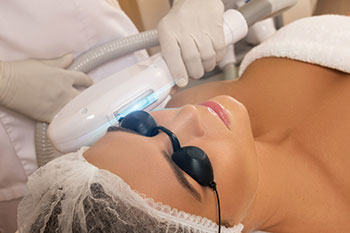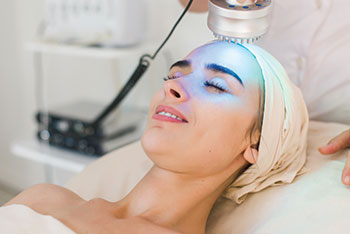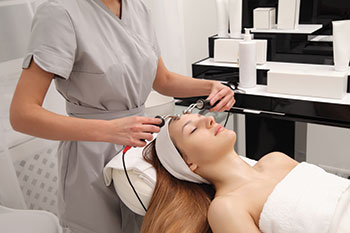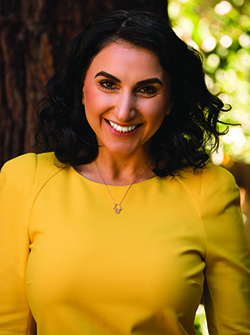When it comes to anti-aging equipment, the variety of products and modalities available to professionals today is incredible, to say the least. Yet, having so many options at one’s disposal can be overwhelming, especially when trying to maximize efficiency, client satisfaction, and profits. What factors should be considered when trying to decide between LED and microcurrent or galvanic and radio frequency?

With all the constant advancements in the industry, aestheticians have never been in a better position to achieve the best anti-aging results for clients’ skin. There are endless choices of products and modalities available that promise to improve the bottom line, attract and retain new clientele, and gain a competitive edge over other skin care professionals in the area.
Having a results-oriented product line is one part of the equation, the other is purchasing the right tools and equipment. In selecting the right equipment, take into consideration budget, the space in the treatment room, and clientele demographic. Will this device increase profits and how long will it take to recuperate the cost of the device?
In addition to the factors above, professionals may only operate devices that are listed within their scope of practice as an aesthetician. Although all of the equipment in this article is intended for anti-aging and rejuvenating purposes, not all of it is accessible to aestheticians. For example, intense pulsed light (IPL) and laser devices are designed with different wavelength settings. In a medical aesthetics practice, there may be physicians, nurses, physician assistants, and aestheticians. However, in most states, only a physician or registered nurse is allowed to operate IPL and laser machines. To be sure, check the regulations for the state where the spa is located.
In the United States, there are four classes of medical devices. The class is an FDA classification that refers to how aggressive the device is and whether it requires a physician or nurse under the supervision of a doctor to operate it. Several types of lights will be discussed in this article. They are all different and are classified as Class I through Class IV. LED lights are (most likely) classified as Class I or Class II and IPL and laser are Class III or IV medical devices found in medical offices and medical spas.
Though most IPL and lasers are medical devices and are not included within the aesthetician’s scope of practice, the light device that can be purchased as an aesthetician is an LED light therapy tool, which is the gentlest type of light treatment, with
no contraindications.
LASER
Laser is an acronym. It stands for Light Amplification Stimulated Emission Radiation.
An IPL laser usually gives good results for diminishing redness and fresh hyperpigmentation and stimulating mild collagen growth. A series of six is recommended, and the cost is usually around $500.
Photorejuvenation laser treatments are most commonly used for lightening and removing hyperpigmentation on the face, neck, chest, hands, and other areas of the body, as well as reducing redness and rosacea. It has a lesser effect on improving skin texture through collagen stimulation and improves pore size minimally by temporarily reducing oiliness. Like all laser treatments, it is best to do this treatment in the winter and the client will need maintenance treatments when brown spots reappear, usually once or twice a year. This treatment can be administered by a doctor, certified physician assistant (PA-C), advanced registered nurse practitioner (ARNP), registered nurse (RN), or medical assistant (MA).
During the treatment, the IPL device sends short, concentrated, pulsating beams of light to irregular skin. The light bypasses the epidermis and gently heats the cells in the dermis. The fibroblasts start to produce more collagen, which improves texture and fine wrinkles. The new skin that forms is smoother and firmer. The client has a sensation of light sunburn immediately after the treatment and may experience prolonged redness, swelling, oozing, delayed wound healing, scarring, crusting or scabbing, pigmentary changes, and acne flareups.
Fractional lasers are newer and also treat wrinkles and post-acne scars. The non-ablative fractional lasers may cost as much as $5,000 for six treatments and have a two day down-time. This laser will take two to six months to give the best results.
Ablative fractional lasers have a four to eight day down-time and give better results for the wrinkled areas on the neck. The cost of this procedure is usually $1,000 to $2,000 per treatment and a series of four is recommended over a six-month time span.
 LIGHT HEAT ENERGY (LHE)
LIGHT HEAT ENERGY (LHE)
LHE skin rejuvenation uses the combination of light and heat energy at low frequencies to target the dermis. This process is completely safe for the client and requires little downtime. The natural fusion of light and heat energy increases overall effectiveness of the procedure and speeds up the healing process compared to other skin rejuvenation techniques that only use light or heat. Skin rejuvenation also accelerates blood circulation, allowing better absorption of anti-aging serums and creams.
LHE skin rejuvenation can be separated into several treatments used to treat skin concerns that most clients experience in older age. These treatments include: collagen renewal, wrinkles reduction, rosacea treatment, pigmented lesion treatment, and vascular lesion treatment.
Using LHE technology, skin rejuvenation works by applying short pulses of light and heat energy into the dermal-epidermal joining area deep in the skin. The procedure affects the skin just enough to trigger a wound-healing response, which produces new collagen under the undamaged layer, thereby replacing the old collagen. Fibroblast stimulation then occurs to help further build collagen and elastic fiber cells in the connective tissue of the inner layer of the skin. The effect of the LHE method gives the skin the elasticity it needs to look firm and plump.
The skin rejuvenation process can occur over a few weeks or up to a few months. During this time, the wound-healing response will significantly improve skin tone and texture. The healing process will also fade away fine lines and wrinkles. Depending on the type of treatment, a full treatment course ranges from six to eight sessions spaced one to three weeks apart to get maximum results.
LED
After the age of 30, people lose approximately one percent of collagen per year. To rejuvenate the skin, and stimulate collagen and elastin production, one of the best modalities is LED – a tiny computer chip encased in glass. Red or amber anti-aging LED therapy is non-invasive, painless, and requires no recovery time. It is safe for all skin types and tones and a full treatment requires only 20 minutes.
Each LED wavelength (color) of light provides unique therapeutic benefits. Blue kills germs and bacteria; amber stimulates collagen and elastin; red stimulates circulation and calms down inflammation; and infrared heals and calms the skin, and also improves product absorption. The best combination of lights for anti-aging and skin rejuvenation is red, infrared, and amber together. This type of light synergistically minimizes the appearance of large pores, increases moisture retention, prevents environmental damage, renews the skin, and encourages new collagen production. Such lights are available in a handheld version for home use, as well as panels, for faster and more convenient treatment room services. LED lights can be used by aestheticians in all states with no physician supervision.
Panel LED lights are the most convenient type of phototherapy equipment, since they do not require direct hands-on supervision and cover a larger treatment area than a handheld for a full 20-minutes. This type of treatment can be added as an à la carte to a service menu and is also beautifully incorporated into the facial with clear serums, creams, and masks. Clear products work best because they allow the light to shine through, uninterrupted. Using the LED panel with peptide serums, creams, and masks increases the efficacy of the light and promotes instant and cumulative skin tightening and reduction of wrinkles.
 GALVANIC
GALVANIC
Galvanic current is a constant and direct current (DC) that uses a positive and negative pole to produce the chemical reactions when it passes through tissues and fluids in the body. The two main reactions of the galvanic machine are ionic iontophoresis and chemical desincrustation.
For the best anti-aging results, both desincrustation and ionic iontophoresis are advised. In the beginning of the treatment, desincrustation is used. Desincrustation is a deep cleansing treatment that softens and emulsifies sebum and is ideal in preparing the skin for extractions. It should be done after cleansing the skin, using desincrustation fluid – a type of alkaline solution, made from sodium chloride, that causes an alkaline reaction to soften follicles for deep cleansing.
At the end of the facial, the galvanic machine can be used to penetrate products. Starting with desincrustation reduces the barrier properties of the skin by assisting with exfoliation, making it easier for ions to move across the skin during iontophoresis.
Although this is a very commonly used machine in an aesthetician’s scope of practice, do not forget to make sure the client fills out the consultation form and is not contraindicated to receive a galvanic treatment. Contraindications for using a galvanic device are pregnancy, metal implants, pins in the face or body, epilepsy, pacemaker, and high blood pressure.
Along with the galvanic machine, some of the most popular modalities among aestheticians in skin tightening and firming are microcurrent and radio frequency. The ideal client for a microcurrent or radio frequency (RF) procedure is anyone over the age of 21 who may be concerned with wrinkles, loss of skin tone, muscle tone, and elasticity, as well as clients complaining of an overall droopy appearance – sagging jowls, flat cheekbones, and pronounced nasolabial folds.
MICROCURRENT
As far as this modality is concerned, it is less about improving the skin’s texture, and more about tightening the muscles. Microcurrent mimics the body’s own natural bioelectrical field and sends tiny electrical currents to muscles. Two ball probes, negative and positive, with currents running between them, stimulate the muscle, causing tightening. Microcurrent devices lift and re-educate muscles, creating a lifted and convex appearance. Combining ultra low frequencies with a modified waveform enables the microcurrent to recharge the electrical potential of the muscle by stimulating the spindle cell fibers that run the length of the muscle.
Originally developed for treating facial palsy, microcurrent devices are used in aesthetic practices to re-educate muscles; increase blood and lymph circulation; enhance the penetration of the active ingredients of skin care formulations; increase the production of collagen and elastin; and increase protein synthesis, gluconeogenesis, and cell membrane transport.
Additionally, research has shown that microcurrents may help with anti-aging at an even deeper level – in studies, it has increased levels of adenosine triphosphate (ATP) in laboratory rats’ skin cells by 500 percent. These devices come in a variety of sizes and intensities, ranging from free-standing units to table tops and handhelds.
RADIO FREQUENCY
Radio frequency (RF) is a procedure commonly used for the treatment of skin laxity from an increase in tissue temperature. This is an anti-aging modality that produces a selective and controlled rise in tissue temperature from a high-frequency alternating current (0.3 to 10 MHz). The rising of temperature and the depth of heating depend on the level of energy used and on the impedance of biological tissues. The goal is to induce thermal damage to, thus, stimulate neocollagenesis in deep layers of the skin and subcutaneous tissue. After a series of treatments, the facial skin in the treated areas appears more firm and tight.
As with microcurrents, RF devices come in a variety of sizes and intensities, ranging from free-standing units to table tops and handhelds.
Take ample time in selecting the best modalities for the treatment room. Consider the devices that are within scope of practice, as well as within budget. Do not blindly follow the trends but do research and make the most educated purchase for client demographic and budget. When used correctly and in combination with the right products, these devices are sure to increase the bottom line and provide the best, non-surgical, facelift results clients are looking for.
 Dasha Saian is the co-founder and current CEO of Saian Natural Clinical Skincare and has over 17 years of experience in the spa industry. In addition to her business and marketing degree, she is a licensed aesthetician, certified nutrition and wellness consultant, an official ambassador of the Aesthetics International Association (AIA), and a certified family herbalist. Saian gives lectures and classes internationally and regularly contributes to global trade publications. She is an expert adviser on natural living, alkaline diet, alternative oncology protocols, and positive body image.
Dasha Saian is the co-founder and current CEO of Saian Natural Clinical Skincare and has over 17 years of experience in the spa industry. In addition to her business and marketing degree, she is a licensed aesthetician, certified nutrition and wellness consultant, an official ambassador of the Aesthetics International Association (AIA), and a certified family herbalist. Saian gives lectures and classes internationally and regularly contributes to global trade publications. She is an expert adviser on natural living, alkaline diet, alternative oncology protocols, and positive body image.